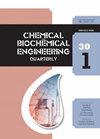雀稗草基吸附剂去除污水中罗丹明B的研究
IF 0.9
4区 生物学
Q4 BIOTECHNOLOGY & APPLIED MICROBIOLOGY
引用次数: 12
摘要
报道了雀稗草废对罗丹明B染料的吸附潜力。利用各种技术对草废弃物进行了活化和表征,分析了活化过程中包含的化学(FTIR)、形态(SEMEDX)和热(TGA)变化。通过改变不同的工艺参数,研究了原料吸附剂和改性吸附剂对污染物的去除效果。对草皮废弃物和活性草皮废弃物的最大吸附量分别为54 mg g-1和72.4 mg g-1。在各种动力学模型中,拟二阶模型的回归效果最好。然而,颗粒内扩散-吸附模型表明,孔隙内的扩散控制了吸附速率。热力学分析表明,罗丹明B吸附过程是吸热自发的。本研究结果表明,草废弃物具有作为有色水处理吸附剂的潜力。本文章由计算机程序翻译,如有差异,请以英文原文为准。
Paspalum notatum Grass-waste-based Adsorbent for Rhodamine B Removal from Polluted Water
The potential of Paspalum notatum grass waste to adsorb Rhodamine B dye from aqueous phase is reported in this research. The grass waste was activated and characterized through various techniques to analyze the chemical (FTIR), morphological (SEMEDX), and thermal (TGA) changes incorporated through the activation process. The pollutant removal efficiency of the raw and modified adsorbents was studied by varying different process parameters in a batch process. The maximum capacity of adsorption which was observed for grass waste and activated grass waste was 54 mg g–1 and 72.4 mg g–1 respectively. Among the various kinetic models, the pseudo-second order model gives the best regression results. However, the intraparticle diffusion-adsorption model showed that the diffusion within pores controlled the adsorption rate. Thermodynamic analysis of this process revealed that Rhodamine B adsorption was endothermic and spontaneous in nature. The results of this study show that grass waste has the potential to be used as an adsorbent for the treatment of colored water.
求助全文
通过发布文献求助,成功后即可免费获取论文全文。
去求助
来源期刊
CiteScore
2.70
自引率
6.70%
发文量
23
审稿时长
>12 weeks
期刊介绍:
The journal provides an international forum for presentation of original papers, reviews and discussions on the latest developments in chemical and biochemical engineering. The scope of the journal is wide and no limitation except relevance to chemical and biochemical engineering is required.
The criteria for the acceptance of papers are originality, quality of work and clarity of style. All papers are subject to reviewing by at least two international experts (blind peer review).
The language of the journal is English. Final versions of the manuscripts are subject to metric (SI units and IUPAC recommendations) and English language reviewing.
Editor and Editorial board make the final decision about acceptance of a manuscript.
Page charges are excluded.

 求助内容:
求助内容: 应助结果提醒方式:
应助结果提醒方式:


